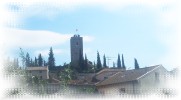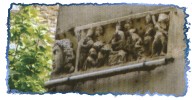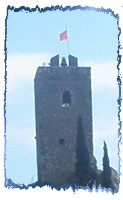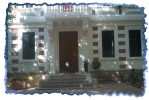







 |
|||||||||||||
 |
 |
 |
|||||||||||
| |
|||||||||||||
 |
|||||||||||||
| |
|||||||||||||
 |
|||||||||||||
| |
|||||||||||||
 |
|||||||||||||
| |
|||||||||||||
 |
|||||||||||||
|
GEOGRAPHIC
SITUATION |
Cessenon sur orb is a large rural market town situated half-way between the Cévennes mountain range and the Méditerranean sea (Valras-Plage at 30 kms). It is the centre point within the local commune and the villages of Cazedarnes, Causses et Veyran, St Nazaire de Ladarez, Roquebrun, Ceps and Prades-sur-Vernazobre are all within a 9 kms radius.
At 51 metres above sea level Cessenon stands down stream of the river Orb famous for its imposing rapids and international canoeing competitions.
![]() HOW
TO FIND US
HOW
TO FIND US
By road : Take motorway A9 exit BEZIERS OUEST (take to the right, direction St Pons), Maureilhan, Cazouls-les-Béziers and Cessenon-sur-Orb.
By air : Served by Montpellier airport (90 kms distance) And by Beziers airport (35kms distance)
[Return in the top of the page]
 |
HISTORY
|
 |
Cessenon-sur-Orb, snuggled up in side of hill on a buckle of Orb, is one of the most old cities of Languedoc. Formerly capital of a châtellenie of 30000 hectares, Cessenon does not count any more today than 1760 inhabitants for a 3750 hectare surface.
The origin of its name :
Celtic or Iberian.
Halfway the first foothills of Cevennes and Mediterranean coast, Cessenon
possesses a natural beauty on one hand (the undergrowth and the scrubland mix
by giving a multiplicity and a variety of strong essences of pleasant smells
such the sweet chestnut tree, the holm oak, the arbousier or the juniper), and
a strategic situation on the other hand.
So conquests and occupations succeeded one another and numerous tracks of these
different times are visible even today:
- Prehistoric time (dolmen, tumulus, flint)
- Time Wisigothe and Sarrazine (said places " Maurerie, Sarrazy ", fall Moslem,
norias, chadouf)
- Time Roman (amphoras, graves, fragment of low funeral relief, villa)
It is however only in the year 973 after the study of our cartulaire that the
confirmation of its age is revealed to us.
Garsinde, widow of the count
of Toulouse gives her castle to Saint Pons's abbey.
Of Garsinde to his daughter Adelaïde, Aton IV to his wife Cécile de Provence,
from Raymond de Trencavel to Hugues de Cessenon, Lords and kings desired our
village.
But in the XIIIè century the war does not save Cessenon. Cathars or Albigeois,
Heretics occupied Noon of France. The pope Innocent III done to preach then
a crusade against them and in 1229 an army driven mercilessly by Simon de Montfort,
then by Louis VIII set the crusaders of the North to the Lords of Noon. The
feudal period ends by the fastening of Languedoc with the royal domain, the
royal period begins.
In 1247, Saint Louis gives the Seigneury of Cessenon to the Seneschal of Carcassonne, Hugues Arcis. For Cessenon begin a fatal period oppressed by baillis, epidemics ( the plague), the bad weather (destruction by the cold of the vineyard and the olive trees).
At the beginning of the XVIè century, one truth dynasty of hereditary feudal lords, Fraissinet de Vessas is born. The village gets up, however the castle taken and resumed in several times undergoes numerous insults. The passage of the soldiers amounts every time to a devastating plague. The biggest mutilations are notably imposed on him in 1582 during the religious wars by the men of the captain Bacon and in 1585 by Henri de Joyeuse.
The villagers, during a visit in Louis's XIII Montpelier, asks the demolition of the castle. It is actual in 1633. Only a massive tower serving as bell tower guards the place of the fortress. Henceforth the feudal lords occupy peacefully their big lordly house in the street "Font Sucrée" (The sweet fountain street).
From 1640 and for one and a half-th century the family of the princes of Cop de Conti enjoy our châtellenie. Having been appointed by Louis XIII, governor of Languedoc, the Count of Provence, brother of Louis XVI, buys this one. The Revolution dispossesses him 5 years later. The providence compensates him: he will become king Louis XVIII
After 4 Revolutions, 2
Empires, the republican system is established in 1875.
1835: Creation of Font Sucrée
(SWEET FOUNTAIN)
1866: Favorable opinion for the execution of the railway
1895: The vineyard is destroyed by the phylloxera
1901: Construction of the Town
Hall
1907: Agricultural syndicalism, revolt of the wine growers supported
by the soldiers of the 17-th R.I.
1930: Inauguration of the Suspended
Bridge
[Return in the top of the page]
 |
PATRIMONY
|
 |
 |
Fragment of Roman sarcophagus dating the 1-st century later J.C who represents a funeral banquet found in the tiled floor of the church. One can discover him(it) on the facade of a house, a marketplace. |
Cessenon called in the acts of Cartulaire Cecenno, Ceceno, Cenceno, Cesseno appears only in the second half of the X-th century. |
 |
|
|
 |
Standing on a rock to the rear of the old defense system, the keep marks the spot of the old fortress square. Thirteen metres high it’s entrance door is of the romanesque style. The clock dates back to the 17th Century. The tower houses three large cast-iron bells named respectively Marie-Rose, Radegonde and Pierre who have for many years signalled both our joy and sorrow with the same three notes ‘Do Si and Lah’ |
Ancient chapel castrale dedicated to Our Lady of the Barthe, it was adjacent to the outer walls of the castle. |
| A compoix ( ancient cadastre) mentions it in 1560. Saint Roch (Montpeller towards 1295 - id v. 1327) will be called against the plague and the contagious diseases and its cult will develop from the XV-th century. |
|
|
|
|
Situated just outside the town walls the town boasts another fountain dating back even further as in the local records it is first mentioned in 1555. |
 |
|
|
|
|
|
|